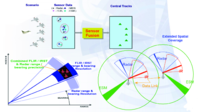
Photo from wikipedia
BACKGROUND AND OBJECTIVE [18f]-fluorodeoxyglucose (fdg) positron emission tomography - computed tomography (pet-ct) is now the preferred imaging modality for staging many cancers. Pet images characterize tumoral glucose metabolism while ct… Click to show full abstract
BACKGROUND AND OBJECTIVE [18f]-fluorodeoxyglucose (fdg) positron emission tomography - computed tomography (pet-ct) is now the preferred imaging modality for staging many cancers. Pet images characterize tumoral glucose metabolism while ct depicts the complementary anatomical localization of the tumor. Automatic tumor segmentation is an important step in image analysis in computer aided diagnosis systems. Recently, fully convolutional networks (fcns), with their ability to leverage annotated datasets and extract image feature representations, have become the state-of-the-art in tumor segmentation. There are limited fcn based methods that support multi-modality images and current methods have primarily focused on the fusion of multi-modality image features at various stages, i.e., early-fusion where the multi-modality image features are fused prior to fcn, late-fusion with the resultant features fused and hyper-fusion where multi-modality image features are fused across multiple image feature scales. Early- and late-fusion methods, however, have inherent, limited freedom to fuse complementary multi-modality image features. The hyper-fusion methods learn different image features across different image feature scales that can result in inaccurate segmentations, in particular, in situations where the tumors have heterogeneous textures. METHODS we propose a recurrent fusion network (rfn), which consists of multiple recurrent fusion phases to progressively fuse the complementary multi-modality image features with intermediary segmentation results derived at individual recurrent fusion phases: (1) the recurrent fusion phases iteratively learn the image features and then refine the subsequent segmentation results; and, (2) the intermediary segmentation results allows our method to focus on learning the multi-modality image features around these intermediary segmentation results, which minimize the risk of inconsistent feature learning. RESULTS we evaluated our method on two pathologically proven non-small cell lung cancer pet-ct datasets. We compared our method to the commonly used fusion methods (early-fusion, late-fusion and hyper-fusion) and the state-of-the-art pet-ct tumor segmentation methods on various network backbones (resnet, densenet and 3d-unet). Our results show that the rfn provides more accurate segmentation compared to the existing methods and is generalizable to different datasets. CONCLUSIONS we show that learning through multiple recurrent fusion phases allows the iterative re-use of multi-modality image features that refines tumor segmentation results. We also identify that our rfn produces consistent segmentation results across different network architectures.
Journal Title: Computer methods and programs in biomedicine
Year Published: 2021
Link to full text (if available)
Share on Social Media: Sign Up to like & get
recommendations!